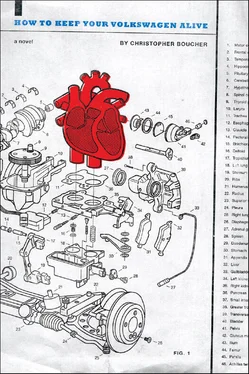“Grab a leaf!” I said. I ran towards the closest one and tackled it.
“_____!” the Chest of Drawers yelled.
This was western Massachusetts — unpredictable; a changing, moving bitch; a switcher of faces that always seemed to press against me. How could I have made any sort of progress here when mountains were mountains one moment and something else the next; when people were here one day and then gone ? It — Northampton, Hampshire County — wanted me to fail, to lose, to get lost in the changing no’s and news and neveragains.
Not without a fight, you shiftshaping cunt!
The leaf grunted and wriggled in my arms. “Get the fuck off of me,” she said.
I pulled down on it. “We can’t let it change its mind!” I yelled back to the Chest of Drawers and the VW. It was September. The leaves had suffered and were now lying dead on the trails.
But it was already too late — the mountain had already started to change, in my mind and the minds of others. I’d thought that if I could contain at least one piece of it I might affect the whole. But it didn’t work — the leaf was just too strong. I pressed all my weight on her but still she rose. Her veins pulsed and I could feel the muscles beneath her skin. “You want to tussle — is that it?” she said.
The Chest of Drawers and the VW, meanwhile, were screaming at me — the VW yelling “Dad!” and the Chest of Drawers telling me to give in, to let go. But I could hardly hear them. I held onto the leaf as she twisted and turned. Finally, she balled up her fist and springfielded me in the face.
Her punch was an ocean. I blinked and opened my eyes just in time to see another leaf-fist smash me. I let go of her and fell to the ground on my back, and the leaf fell on top of me, straddling my chest and swinging her fists and crushing my face and my stomach. I saw helping hands above me — the Chest of Drawers and the VW, trying to grab the leaf and pull her off — but she was a fury. She shook them off and bore into me with fists like aircraft carriers. She punched right through the page!
My face never did run the same after that day. That leaf broke bones that never healed correctly. To this day, I still can’t properly smile — whenever I do it’s a police lineup.
THE VOLKSWAGEN IS MUSIC
The Volkswagen stores its notes, phrases and all things music in something called the Words and Pictures Coil, which is located in an eight-inch steel cylinder right next to the memory coil. In fact, you can find the Words and Pictures Coil by tracing the morning cables from the memory coil (the two exchange information constantly). There will be several cables to choose from; the shortest will lead to the Words and Pictures Coil.
For some reason, though, Volkswagen only installs 30 centimeters (about 4.5 wraps) of coil to the Words and Pictures Coil at the factory, which isn’t nearly enough for the car to retain all the language it needs to (I’ve written to Volkswagen repeatedly to ask them why they can’t trade one or two of the eight wraps for counterverbs or more complex rhythms, but each time I do they reply with a form letter and a bunch of Volkswagen catalogues.). You may therefore find that you need to open up the coil from time to time to remove clogged or unstuck notes, or to clear out notes you aren’t using so that others can be stored. Please note: Occasional clogs aren’t a sign that anything is wrong — they’re a fact of any Volkswagen.
To unclog a coil, first disconnect the morning cables that attach at either side. Then undo the clasps that hold the top cover down. The cover should come right off. Underneath it you should see the first layer of copper coil. You should see some notes in there, as well as memories, dreams and off-roads.
Take your missing and flush the top of the coil. Be selective — remember that the missing is powerful, and that anything you remove from the coil is gone for good (I’ve known gerunds who’ve tried to fix their errors by opening up their missing, reassessing the memories or notes and placing them back in the coil, but that’s a very messy job. And their Volkswagens were completely confused.). Hopefully, this is enough. If not, you need to detach the coil from its housing (using a triplet-wrench with an extension to get to the bolt that holds it in place) and clean the coil more thoroughly.
Again, though, you’re only looking for clogged or unstuck notes — a layered melody, an obvious dischord. Everything else stays right where it is.
TUNING
Your Volkswagen should be tuned for stories at the factory, but many owners find that their cars need retuning after a few years of roadtime. I’ve received letters from owners whose cars are producing off-notes or — words, and I’ve heard from others whose cars are flat in pitch or tuned to the wrong key. This will stilt the notes’ ability to project or travel, of course, and the VW will be less likely to want to play.
There are two factors at work here. First, remember that every note/word takes time, and that you or your VW are always searching for the least costly option. The sentence is a machine, and what we’re essentially talking about is swapping factory parts for after-markets. If chosen right, though, the cheap words should still vibrate at a frequency that is similar enough to the original or intended word for you to hear the suffering, joy or surprise.
Choosing such words correctly, though, is almost an art in itself. It may be that your Volkswagen runs just fine, but that you or he/she are making poor word-to-time ratio decisions. Check your words — are they turning at the right speed?
If the ratio appears correct, you may have a mechanical problem. If so, the best way to find it is to run a diagnostic on the parts employed and consider which one is the culprit. Your Volkswagen can sound out of key, first, if its sensors aren’t working properly, or if the morning cables that compliment them aren’t clear and sunny.
If both the sensors and the cables seem sound, check the pedals. Do they push to the floor easily (but not too easily)? Study the top of the pedal as you push it. Is it attached correctly to the cable? If so, the cable should be taut when the pedal is pushed in.
Or it may be that the car’s just fine. Are you sure that it isn’t you who’s out of tune?
NOTE CONTROL
While you can’t contain the notes, you do have some control. The sounds your Volkswagen emits, that is, are directly connected to a) the syntactical choices you and your VW make (the letters you choose to tie to your experiences and the word choice, sentence structure and phrasing you employ), b) the positioning of those pedals in the car that are connected to the reeds. I say more about the foot pedals later on, but for now you should realize that it’s your responsibility to determine which reeds each pedal turns (as each Volkswagen is different), to label them accordingly, and to begin familiarizing yourself with the ways in which pedal control can create notes, chords and “riffs.”
PRACTICE
I can’t emphasize this one enough. If you want your Volkswagen to make interesting, thoughtful music — music with muscle that can transport, change the weather or beat someone up — you have to make them practice. My VW used to practice a half an hour a day. We’d practice 3/4 counts, 4/4 counts, 6/8 counts, cut language timing, senteggios and so on. The VW might find these exercises tedious, but they’re exactly what you need to begin creating lively, original sentences.
I’d also suggest that your VW practice scales, a new one each week. I started my VW on the pit scale (pit-pot-put-pat-pet), but another good one is the calendar scale (calendar, centerpiece, cylinder, collateral, cutthroat), or the student scale (student, standart, stelling, stillpaul, stol ). Any one will work to start with, as long as it helps the VW begin to hear words as a series of sounds, helps them understand that each word has inherent musical qualities, and helps you get a sense for the reeds and the pedals.
Читать дальше












